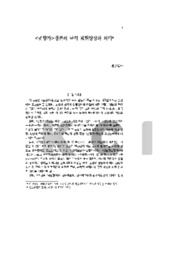

-
미리보기
서지정보
· 발행기관 : 판소리학회
· 수록지 정보 : 판소리연구 / 31호 / 239 ~ 266페이지
· 저자명 : 서유석
초록
본고는 판소리 연행 현장에서 드러나는 창자의 다양한 동작 양상을 살펴, 그 창자의 동작이 가지고 있는 기능과 의미가 무엇인지 살피는 것을 연구 목적으로 삼는다.
판소리 창자의 연행 동작은 크게 ‘너름새’, ‘발림’, ‘사체’와 같은 용어로 지칭되었는데, 이 중 ‘너름새’는 극적 동작을, ‘발림’은 음악적 혹은 관습적 동작을, ‘사체’는 너름새와 발림의 중간적 의미로 사용되었던 것으로 보인다. 최근 이들 용어는 ‘발림’으로 통합되었으나 각각의 용어가 가지고 있는 원래의 개념적 의미는 지금 판소리 연행에서 창자가 보여주는 동작에 모두 포함되어 있는 것으로 볼 수 있다.
판소리 연행 동작은 크게 1) 창자가 사건에 대한 시점을 극중 인물과 일치시켜 등장인물의 감정, 행동을 재현하는 동작, 2) 창자가 사건에 대한 시점을 관객과 함께 일치시켜 극 중의 상황을 재현하는 동작, 3) 창자가 사건에서 벗어나 관객에게 말을 건네 연행 상황에 참여시키거나 연행의 흐름을 벗어나는 동작, 4) 서사의 진행 혹은 창의 시작과 끝을 알리는 표시와 같은 동작, 5) 창자가 사설의 내용에 따른 음악적 구성에 따르는 동작으로 나누어 그 의미와 기능을 확인할 수 있다.
1)과 2)는 판소리 서사를 극적으로 재현하는 ‘극적 동작’으로, 3)과 4)는 연행에서 드러나는 창자의 ‘관습적 동작’으로 5)는 판소리 음악 구성에 따르는 관습적인 ‘음악적 동작’으로 그 의미와 기능 양상을 구별할 수 있다.
창자의 연행 동작은 관습적 동작으로 이야기의 시작이나 노래의 시작을 알리는 것에서부터 출발하여, 다시 이야기와 노래의 끝을 알리는 관습적 동작으로 종결되는데, 그 사이 이야기를 재현하는 극적 동작과 음악적 구성에 따르는 음악적 동작이 함께 드러나고 있는 것으로 보인다. 다시 말해서 창자의 연행동작은 관습적 동작을 통해 이야기와 노래의 시작을 알리고, 극적 동작을 통해 서사 상황에 관객의 집중과 동화를 유도하며, 다시 관습적 동작을 통해 이야기와 노래의 끝을 관객에게 지시하고 있음을 확인할 수 있다.영어초록
The purpose of this paper is to examine diverse appearance of movements of the pansori singer revealed in the pansori performance field.
The movements of pansori singer’s performance are expressed by the terms such as ‘neoreumsae’, ‘balim’, and ‘sachae’, of which it appears that ‘neoreumsae’ means dramatic movements, ‘balim’ musical or customary movements, and ‘sachae’ in-between ‘neoreumsae’ and ‘balim’. Recently these terms were integrated into ‘balim’ but it can be seen that all of the conceptual meanings of the terms are contained in the movements shown by the singer in the present pansori performance.
The meanings and functions of the movements of pansori performance can be examined by dividing the movements into the following: 1) the movements representing the emotion and actions of characters made by the singer who accords the time of the events with the characters in the play, 2) the movements representing the circumstances in the play made by the singer who accords the time of the events with the audience, 3) the movements of the singer getting out of the events in the play and speaks to the audience to make the audience participate in the circumstances of performance or of the singer getting out of the flow of performance, 4) the movements like signs showing the beginning and the ending of the progress of narration or pansori, and 5) the movements of the singer following the musical composition in accordance with the contents of narration.
The meanings and functions of the movements can be categorized into above-mentioned 1) and 2) of ‘dramatic movements’ representing pansori narration dramatically, 3) and 4) of ‘customary movements’ of the singer shown in performance, and 5) of customary ‘musical movements’ in accordance with musical composition of pansori.
The movements of the singer’s performance begin with showing the beginning of narration or singing as customary movements and end with the customary movements showing the ending of narration or singing and it appears that between these movements, the dramatic movements representing stories and musical movements in accordance with musical composition are shown together. In other words, it can be confirmed that the movements of the singer’s performance signal the beginning of stories and singing through customary movements and induce the concentration and assimilation of the audience into the circumstances of narration through dramatic movements, and inform the audience of the ending of stories and singing through customary movements again.참고자료
· 없음태그
-
자주묻는질문의 답변을 확인해 주세요

꼭 알아주세요
-
자료의 정보 및 내용의 진실성에 대하여 해피캠퍼스는 보증하지 않으며, 해당 정보 및 게시물 저작권과 기타 법적 책임은 자료 등록자에게 있습니다.
자료 및 게시물 내용의 불법적 이용, 무단 전재∙배포는 금지되어 있습니다.
저작권침해, 명예훼손 등 분쟁 요소 발견 시 고객센터의 저작권침해 신고센터를 이용해 주시기 바랍니다. -
해피캠퍼스는 구매자와 판매자 모두가 만족하는 서비스가 되도록 노력하고 있으며, 아래의 4가지 자료환불 조건을 꼭 확인해주시기 바랍니다.
파일오류 중복자료 저작권 없음 설명과 실제 내용 불일치 파일의 다운로드가 제대로 되지 않거나 파일형식에 맞는 프로그램으로 정상 작동하지 않는 경우 다른 자료와 70% 이상 내용이 일치하는 경우 (중복임을 확인할 수 있는 근거 필요함) 인터넷의 다른 사이트, 연구기관, 학교, 서적 등의 자료를 도용한 경우 자료의 설명과 실제 자료의 내용이 일치하지 않는 경우
“판소리연구”의 다른 논문도 확인해 보세요!
-
판소리 사설에 나타난 관용적 지식 담론의 문화적 의미 34 페이지
본 연구는 그 간 삽입가요 혹은 단위사설이라 불리던 일련의 사설들 중 상당수가 관용적 지식의 형태로 판소리에 수용되어 있음에 착안하여 당대 지식 문화의 추이와 관련하여 새로운 관점에서 판소리의 문화적 위상을 드러내어 보는 것을 목표로 하였다. 이를 위해 우선 판소리 사설에 나타난 관용적 지식의 유형을 그 추상화의 수준 및 계층성, 전문성을 기준으로 하여 民.. -
유성기 음반과 판소리 사설의 변화 양상 24 페이지
유성기음반에서 일어난 변화에는 의도적인 것과 비의도적인 것이 있다. 의도적인 것으로는 창자가 의도적으로 변화를 꾀한 것과 음반 제작사가 의도적으로 변화를 요구한 것이 있다. 그리고 비의도적인 것으로는 창자의 착각이나 망각 등과 같은 실수에 의한 것과 음반 제작 과정에서 일어난 실수에 의한 것 등이 있을 수 있다. 본고에서는 신재효가 남겨 놓은 사설과 춘향가.. -
판소리와 창극소리의 관련성 24 페이지
20세기 판소리와 창극의 상관성에 주목하는 일은 매우 중요한 의의가 있다. 두 양식 사이에는 구심력과 원심력이 공존하고 있다. 그러면서도 결코 분리되지 않는 태생적인 운명을 공유하고 있다. 창극은 판소리의 영향권 안에 있었고 판소리의 자양분을 기반으로 하여 성장해 왔다. 그렇지만 언제나 ‘판소리 → 창극’의 방향으로만 영향관계가 전개되어 온 것은 아니며, .. -
신재효와 근대 판소리 18 페이지
판소리사에서 근대 판소리의 성립은 19세기 말엽에서 20세기 초반에 이르는 어름에서 잡을 수 있다. 판소리사에서 중요한 역할을 했던 신재효는 1812년에 태어나서 1884년에 삶을 마감했다. 그가 살아간 시기가 근대 판소리의 성립되는 시점에 연결된다. 따라서 우리는 신재효와 근대 판소리 사이에 어떤 접점을 찾을 수 있을 터이다. 19세기에서 20세기에 걸치.. -
문화 변동과 판소리 33 페이지
이 논문은 판소리의 공연문화의 변동과 판소리의 관계를 규명하려는 목적으로 씌어졌다. 이 논문에서는 이전의 연구 결과를 충분히 활용하면서 현상을 기술하는 데 그치고자 하였다. 다만 20세기 이후 전체를 아우르던 쇠잔기는 1964년을 기준으로 쇠잔기와 보존기의 둘로 나누어 각 시기의 특성을 살펴보았다. 첫째 시기는 판소리의 형성기인데, 이 시기의 판소리는 제의..
찾으시던 자료가 아닌가요?
지금 보는 자료와 연관되어 있어요!
문서 초안을 생성해주는 EasyAI




